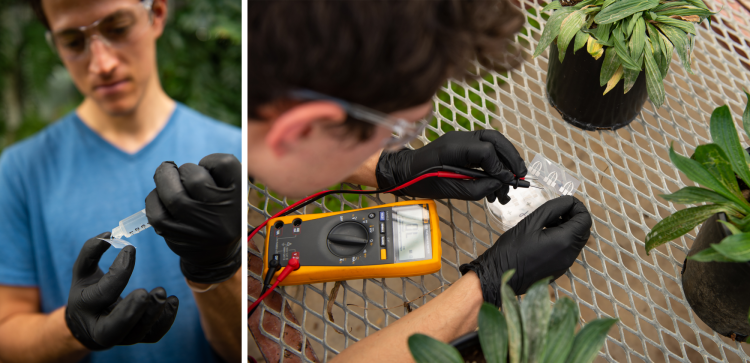In the air, on the ground and everywhere in between
Engineers put remote sensing to work for sustainability
Farmers know how much fertilizer they spread over their fields each year and how much water they use every day. But fine-tuning those amounts can be a challenge because the results from the field either are not available or are hard to analyze.
But what if there were a few tiny, wirelessly linked sensors lodged inside plants throughout their fields? The sensors would constantly measure ambient air temperatures or soil moisture levels and report back in real time about potential issues in their specific sections. They could even test a plant’s sap frequently to check key metrics for growth and suggest actions farmers could take to improve them.
Engineers at CU Boulder are working to make that a reality. It’s one of many interdisciplinary efforts to use the power and promise of remote sensing to help solve food supply, pollution and water scarcity problems around the globe.
Elliot Strand is a PhD candidate in the Materials Science and Engineering Program, studying with Professors Greg Whiting and Robert McLeod. He leads a project that focuses on creating fully printed ion-selective organic electrochemical transistors that can detect macronutrient concentrations in whole plant sap.
Essentially, Strand said, the team has developed a sort of “diabetes test strip for plants” that can quickly measure nutrients like potassium.
“To collect the data, we simply take a drop of sap and put it on these cheap, flexible and disposable sensors,” Strand said. “The best part is we can quickly 3D print these sensors on basically anything — even paper. That means we don’t need expensive and complicated equipment way out in the field to get this valuable, real-time data, and it opens up opportunities to compost or recycle the material after use.”

Elliot Strand drops a sap sample onto an ion-selective organic electrochemical transistors that can detect macronutrient concentrations.
Whiting, a professor in mechanical engineering, said the next phases of the research will likely focus on inserting these sensors into plants. The team will also be looking at different metrics that can be tracked, such as air temperature or specific plant hormones.
A high-level goal when it comes to sustainability, he said, would be helping farmers increase crop yields by fine-tuning the use of water and fertilizer based on sensor readings.
“We have developed a very real stepping stone towards those goals that is also quite usable right now for agriculture or conservation work,” he said.
While Whiting and his team are approaching these problems from the ground, Associate Professor Evan Thomas is coming in from the air. As director of the Mortenson Center in Global Engineering, he and his team are developing the Drought Resilience Impact Platform (DRIP), an integrated systems-based approach to reducing the effects of drought and improving water quality and soil health.
The platform combines NASA satellite data about drought conditions with information from sensors installed on groundwater pumps across hundreds of sites in Africa that alert the network if a pump is failing or in need of routine maintenance. This dual approach — along with modeling and other work — is being used to ensure communities in Kenya and Ethiopia have the knowledge, access and infrastructure to get the water they need.
Thomas said the interdisciplinary work showcased in DRIP and related projects is a great example of the work that needed to be done over the next decade around the globe.
“This platform can also be used in Colorado or anywhere around the globe where water is becoming a scarce resource,” Thomas said. “Over the next few years, I hope we can start to get this data into the hands of regional providers and leaders on the ground to help inform their decision-making and potentially avoid costly and dangerous drought emergencies.”

